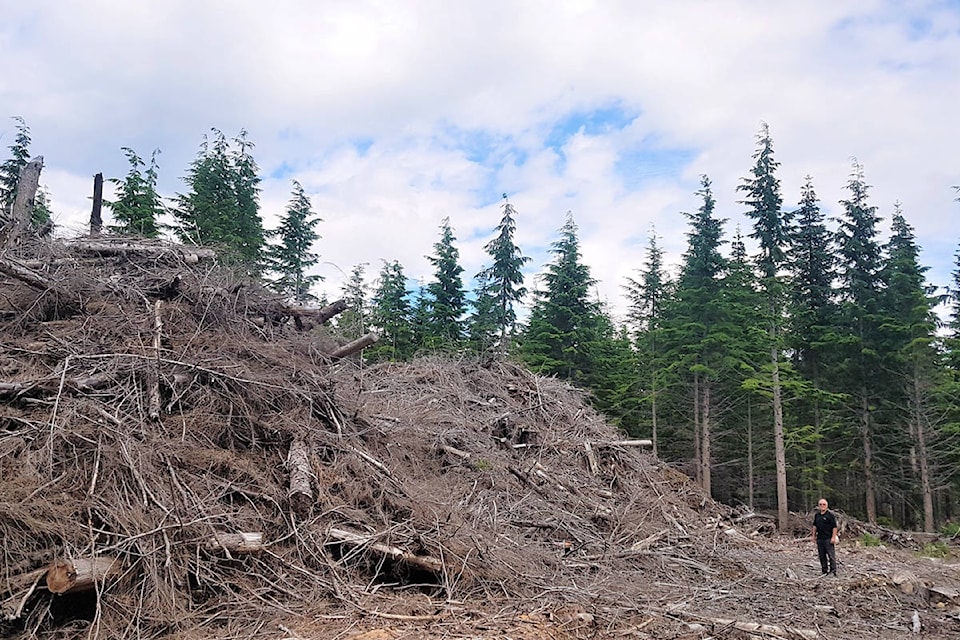The Terrace Community Forest (TCF) has been stockpiling its wood waste fibre for two years. Thanks to a grant just received, that fibre will soon be processed into wood pellets.
The Forest Enhancement Society of British Columbia, which is supported by the provincial and federal government, is supplying the TCF with $443,400 to ship wood waste to the Skeena Bioenergy pellet plant in Terrace.
“The significance of it really is to be able to utilize the full volume of a tree and not have to dispose of it in any other form like burning,” said Kim Haworth, TCF general manager.
Typically, wood waste from forestry operations, also known as fibre, is burned on-site to reduce wildfire risk. Burning the small or poor quality logs, branches and chips releases smoke and greenhouse gasses.
The grant makes it economically viable to ship the waste to the Skeena Bioenergy facility where it will be used to make high-quality wood pellets for several uses including industrial powerplants and both heating and cooking appliances.
One of the benefits of the project touted by the provincial government is reducing greenhouse gas emissions.
“Yes it’s true there is carbon inputs and outputs associated with the processing of this wood and the pellet production,” said Doug Donaldson, minister of forests, lands, natural resource operations and rural development.
“If you consider climate emergency that we have as a global crisis, which it is, then the offsetting of burning dirtier fuels like coal, and the actual controlled burning of these pellets in a pellet production plant where incineration and greenhouse gas emissions are minimized, it’s much more beneficial than having piles burned openly in the forest.”
Donaldson said the pellet industry is “on an incredible upswing” and cited Japan as a country eager to use pellets as an energy source as it transitions away from nuclear power after the 2011 Fukushima nuclear disaster.
“Between Japan and China and European countries wanting to get off coal, the pellet industry is playing a significant role in the forest sector in the northwest and across the north and it provides a good outlet for wood that wouldn’t otherwise be usable by sawmills,” he said.
According to Haworth, the price TCF gets for the fibre depends on its moisture and ash component like needles and bark, factors which are not fully known at this time.
“There’s a limited financial gain for us at this point, we are really at the cusp of this whole program because this is the first time we’ve done a project like this, so we’re really not sure what the exact costs are,” he said.
“There should be a small revenue stream for the Terrace Community Forest but the biggest thing is just being able to utilize the full tree.”
The project started on June 1, and is estimated to support the equivalent of four full-time jobs through the grinding and trucking of fibre.
About 15,000 cubic metres of hemlock and balsam fibre waste has been accumulated by TCF over the past few years during its activities thinning second-growth tree stands. That equates to around 275 truck loads of material stored at the cutting permit areas. Once the fibre wood waste is ground up, its fire potential is minimized because of its compactness and moisture content.
Terrace Community Forest is owned by the City of Terrace. It has forestry tenure on three operational areas in part of the Kitimat Valley, Shames Mountain and the Deep Creek area north of Terrace. The city is not involved in the day-to-day operations of the company. TCF’s mandate is provide employment opportunities in the Terrace area and support recreational and community groups with grant funds.
The Forest Enhancement Society of British Columbia was established in 2016 as a Crown agency to improve damaged or low-value forests, improve wildlife habitat, prevent wildfires and reduce greenhouse gasses. The B.C. government has invested $235 million in the society.
“It’s exciting for the fact we can finally utilize our wood waste and I just hope that the Skeena Bioenergy can develop strong markets into the future and even expand their plant to take higher volumes, because all the licensees within this local area are going to benefit from this pellet plant,” said Haworth.
READ MORE: Is this the world’s cleanest pellet plant?
ben.bogstie@terracestandard.com
Like us on Facebook and follow us on Twitter.
